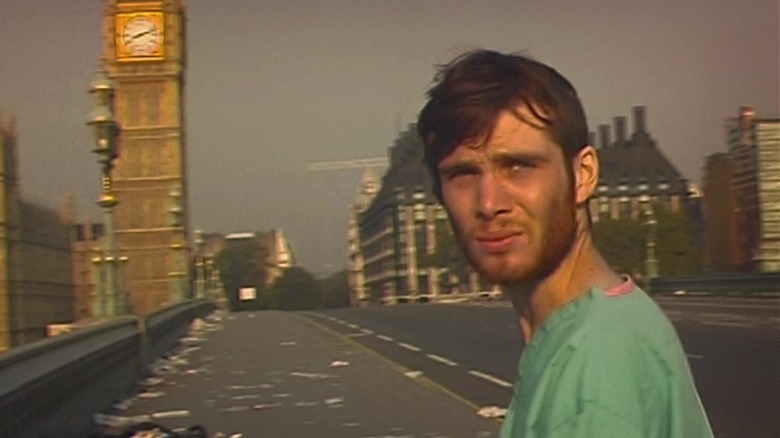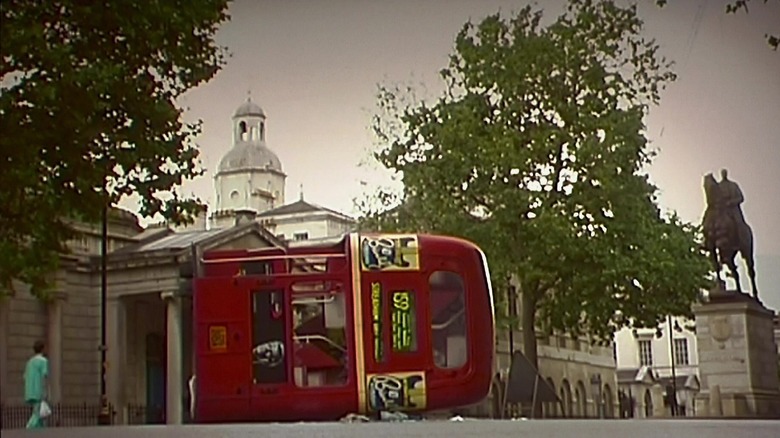The 28 Days Later Scene Danny Boyle Doesn't Think You'd Get Away With Today
Forget the "Walking Dead" comics or the first "Resident Evil" film; it was "28 Days Later" that made zombies cool again in the 21st century. Easily the best zombie movie that technically isn't a zombie movie, director Danny Boyle's sci-fi horror thriller takes place in a nightmare world where society has collapsed following the outbreak of a lab-born, zombie-esque infection dubbed the "rage virus." Many of the film's leads would go on to become far bigger names after its release, including a baby-faced Cillian Murphy as the poor Joe Schmo (or whatever the British equivalent is of that) who awakens from a coma to find London abandoned and overrun with red-eyed, rampaging infected individuals.
The first produced film written by Alex Garland, "28 Days Later" marked the beginning of the storyteller's exploration of transformed landscapes and physical bodies (a motif he's carried over into his non-sci-fi work with the futuristic thriller "Civil War"). In Boyle's movie, the streets of London are now eerily empty, save for when Murphy's character, Jim, is running for his life or rummaging through buildings for supplies with the other survivors he eventually meets. Before that, though, he wakes up to find the hospital he was staying in completely deserted. As Jim traverses Central London on foot, he memorably spots flyers for missing people scattered all over Piccadilly Circus — an image that had become all the more haunting by the time the film reached theaters in 2002, conjuring memories of similar flyers spread across New York after the September 11th terrorist attacks.
9/11 itself occurred after this sequence was shot, which Boyle (no doubt correctly) reckons is the only reason he and his team were able to film it the way they did. That goes double for one of the most unsettling sights Jim encounters in his trek across this post-apocalyptic cityscape.
The overturned bus in 28 Days required some subterfuge
It wasn't just the U.S. that beefed up national security measures ten-fold after 9/11. As part of Inverse's 2023 oral history about the making of the film, Boyle noted that the "freedom" he and his crew had shooting "28 Days Later" in London "was just ridiculous when you look back on it now. We were able to tow in and turn over buses outside Downing Street. Now, they'd be around you with machine guns." Even at the time, though, flipping a double-decker bus onto its side for Jim to pass by in his journey through London required a bit of subterfuge.
In the same interview, line producer Robert How admitted the Westminster Council wouldn't allow the film's crew to lay the bus right outside Downing Street ... so they snuck in at four in the morning and did it anyway. This aligns with what Boyle said on the movie's DVD commentary:
"This, you wouldn't be allowed to do this. We did this before September 11, and to put a bus on its side in Whitehall, literally just outside Downing Street where the Prime Minister residence is, you just wouldn't be allowed to I don't think. We only got away with it by the skin of our teeth. And by the inventiveness of Mark Tildesley, the [production] designer, who swore blind to them that he could get it in and out of there in 15 minutes – and proved himself right."
Brief as this moment may be, it serves to further immerse you in the film's vision of a devastated London. Images like this would once again become a dark mirror of the real world two decades later when the COVID-19 lockdowns resulted in identical visuals of vacant cities the world over (with far fewer flipped buses, thankfully). Perhaps Boyle and Garland's "28 Years Later" is arriving right on time after all.

